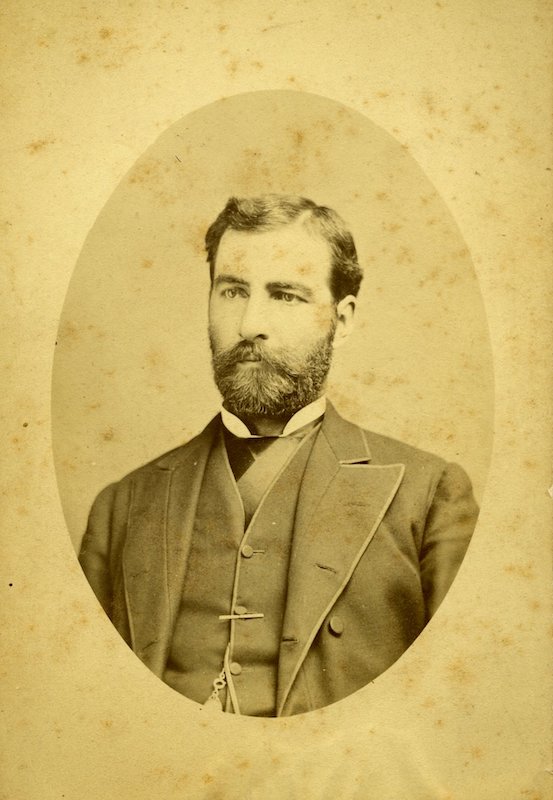
Portrait of Dr. James Milliken, who favored molasses cookies, c. 1885. (Photographer: Ira C. Perry, Gift of Catherine G. Blosser, Sadie Milliken Blosser Collection)
We missed National Cookie Day on December 4th, but it is never too late to celebrate those small, sweet cakes. It is not an official or particularly historic holiday, but cookies do have some interesting history.
The word cookie comes from the Dutch word koekie, which means “little cake” and is likely to have originated in the Persian Empire in the 7th century CE. Persia was one of the first areas to cultivate sugar, the critical ingredient. Cookies were brought to Europe through the Muslim conquests of Spain. By the 14th century, cookies had become common throughout Europe, and Renaissance cookbooks have many recipes for them. They continued to be introduced to other parts of the world through exploration and colonization.
English, Scottish, and Dutch immigrants brought the first cookies to the United States. Our simple butter cookies resemble English teacakes and Scottish shortbread. In early American cookbooks, cookies were given no space of their own, but were listed at the end of the cake chapter. The expansion of the United States was reflected in cookie recipes. The spread of railroads gave cooks access to coconuts from Florida and raisins from California. Around the turn of the century, the Kellogg brothers invented cornflakes in Battle Creek, Michigan, after which cookie ingredients included cereal products. They also patented the first commercially available peanut butter in 1895.
National Cookie Day was started by the Blue Chip Cookie Company in San Francisco in 1987, though Sesame Street’s Cookie Monster had been celebrating it since 1976. His favorite, the chocolate chip cookie, was developed by American chef Ruth Graves Wakefield in 1938 when she owned the Toll House Inn, in Whitman, Massachusetts. She added chopped up bits from a Nestlé semi-sweet chocolate bar to a cookie. Wakefield gave Nestlé the cookie recipe and was repaid with a lifetime supply of chocolate.
After reading about this history, I was inspired to look through some of the old cookie recipes in the Kelley House collections. Our research library and archives contain historic cookbooks and journals with recipes clipped and saved by Mendocino residents. The first I came across, a recipe for macaroons, was printed in an 1889 issue of The Ladies Home Journal which praised them as “a staple for evening parties.”
Macaroons
1 cup sugar
3 egg whites
½ pound blanched ground almonds
½ teaspoon cornstarch
½ teaspoon baking powder
Whip egg whites until stiff; add the sugar slowly, whipping constantly. Fold in the remaining ingredients. Drop the batter from a teaspoon onto a greased cooky sheet. Bake in a slow oven (275 degrees F.) until they are done, about twenty minutes. Do not allow them to become brown. Makes about forty macaroons.
I found numerous gingerbread recipes to choose from, not a surprise since they have been a Christmas tradition since their first documented appearance at the court of Queen Elizabeth I in the 1500s. My favorite recipe, for “Dr. Milliken’s Favorite Molasses Cookies,” was in a Mendocino Presbyterian Church cookbook dating from the early 1900s. James Milliken opened his medical practice in Mendocino in 1883, and in 1884 sent for his wife, Elizabeth (probably the cookie baker), and two children, who were living in Bangor, Maine. Milliken practiced medicine here until his death in 1909. I figured that if these cookies were recommended by the doctor, they must be good for us!
Dr. Milliken’s Favorite Molasses Cookies
Large cup molasses, smaller cup brown sugar, 2 eggs, spices – cinnamon, nutmeg, ginger, lemon and vanilla, to taste – teaspoon salt, 2 tablespoons vinegar, 1 rounded tablespoon soda sifted in flour. Add flour to make real stiff dough.
If the molasses cookies aren’t healthy enough for you, the final recipe I found, “Chocolate Coconut Drops,” comes from New Magic in the Kitchen in the section titled “Some Simple Healthful Treats for Children.” This cookbook was published in the 1930s by the Borden Company to promote Eagle Brand Sweetened Condensed Milk, a staple in cookie baking. Borden had offered U.S. cooks $25 for each original recipe they submitted featuring Eagle Brand, and chose 208 recipes from the 80,000 they received. Elsie, the Borden spokes cow, made her debut in 1938 and she’s been pushing “quick, easy, and foolproof” cookie recipes ever since.
Chocolate Coconut Drops
2/3 cup Borden’s Sweetened Condensed Milk
¼ pound shredded coconut
1 square unsweetened chocolate
Melt the chocolate in double boiler. Add condensed milk and coconut. Mix well, drop by spoonfuls on to a greased pan. Bake in a moderately hot oven 15 minutes.
If you are interested in exploring some of our historic cookbooks, or in adding another cookie recipe to your collection, schedule an appointment in the research office by contacting me at curator@kelleyhousemuseum.org
The Kelley House Museum is open from 11AM to 3PM Thursday through Monday. To visit the research office, make an appointment at curator@kelleyhousemuseum.org Walking tours of the historic district depart from the Kelley House regularly.